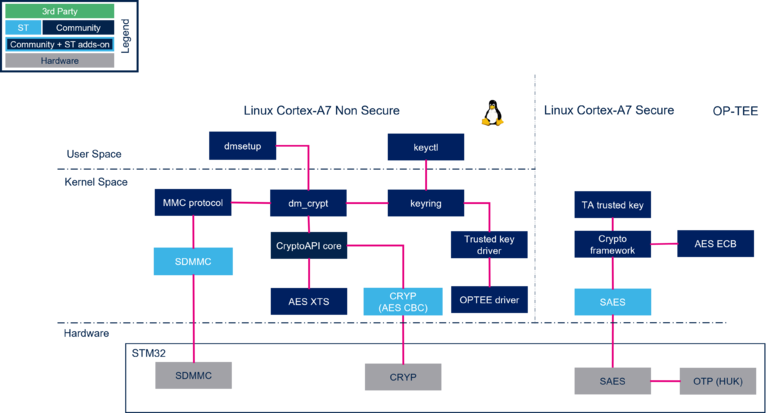1. Purpose of article[edit source]
This article describes how to encrypt a device block for storage as a Sdcard with the "dm-crypt" tool. The encrypting trusted key is protected by the secure OS OP-TEE. The encrypted key is wrapped with the SAES IP.
2. Pre-requesites[edit source]
You are already familiar with the Yocto build process and OpenSTLinux distribution.
3. Introduction[edit source]
This article describe a process to encrypt dynamically a bloc device with "dm-crypt", here a sdcard partition. We use the Linux in-kernel key managment Linux, to create a "trusted key" key type as the bloc device encrypting key. The "trusted key" so the encrypting key is a secure key created, seal & unseal by the secure OS OP-TEE, the wrapping key is a secret key and can be the HUK or derived from the HUK. The Linux user-space application "keyctl" manage secure key blobs, the wrapping is performed by the secure IP SAES in the OP-TEE environment. We use AES encryption algorithm with CBC mode or (ESSIV or XTS). ESSIV and XTS provide more protection for disk encryption and the AES CBC encryption can be accelerated with the CRYP IP.
4. architecture overview[edit source]
5. process[edit source]
- New MMC partition creation
fdisk /dev/mmcblk0
enter "n" following by "+1G" for 1go size then "w".
- check the new partition created
lsblk
NAME MAJ:MIN RM SIZE RO TYPE MOUNTPOINTS mmcblk0 179:0 0 14.8G 0 disk |-mmcblk0p1 179:1 0 256K 0 part |-mmcblk0p2 179:2 0 256K 0 part |-mmcblk0p3 179:3 0 256K 0 part |-mmcblk0p4 179:4 0 256K 0 part |-mmcblk0p5 179:5 0 4M 0 part |-mmcblk0p6 179:6 0 4M 0 part |-mmcblk0p7 179:7 0 512K 0 part |-mmcblk0p8 179:8 0 64M 0 part /boot |-mmcblk0p9 179:9 0 16M 0 part /vendor |-mmcblk0p10 179:10 0 736M 0 part / |-mmcblk0p11 179:11 0 710.5M 0 part /usr/local `-mmcblk0p12 179:12 0 1G 0 part
- Trusted Key creation in keyring session
keyctl add trusted my_key "new 64" @s
result : 53139771
- check the created key, show the keyring session and print the sealed key.
keyctl show @s
result: Keyring 989387511 --alswrv 0 0 keyring: _ses 809952222 ----s-rv 0 0 \_ user: invocation_id 53139771 --alswrv 0 0 \_ trusted: my_key
keyctl print 53139771
result: 00334c376ecf6d8e80d7737506eec2456dea0baa119d86cb0aec5643edfe5bbdcdb736e94075fc6f
832731067e3452a16eb40891ee7cdf2133aa6fbce6b1bd8428f2ca9afece90153e84e0c3c1107f66 1ccc53b88f2e2d9dbb21223e9aeacafff2
- save Key blob
keyctl pipe 53139771 > my_key.blob
- create the device-mapper named crypt_dev with transparent encryption of block device using the kernel crypto API "crypt")
specifically the AES XTS encryption with the trusted ky "my_key" {Board$}}dmsetup create crypt_dev --table "0 $(blockdev --getsz /dev/mmcblk0p12) crypt aes-xts-plain64 :64:trusted:my_key 0 /dev/mmcblk0p12 0"
result: [ 3666.109846] cryptd: max_cpu_qlen set to 1000
- check the device mapper
dmsetup table --showkeys
